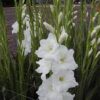**The Growth of Orchids: From Seed to Stunning Blossoms**

Orchids, renowned for their exquisite beauty and diversity, undergo a fascinating journey of growth and development from seed to radiant blooms. As one of the largest and most diverse families of flowering plants, orchids exhibit a wide range of growth habits, reproductive strategies, and environmental adaptations that contribute to their success in various ecosystems around the world. In this article, we will explore the remarkable process of orchid growth, from the germination of seeds to the emergence of vibrant flowers, and the factors that influence each stage of development.
**1. Germination of Seeds**
The journey of an orchid begins with the germination of its seeds, a process that is often complex and requires specific environmental conditions to occur successfully. Unlike most flowering plants, orchids produce tiny, dust-like seeds that lack endosperm, a nutrient-rich tissue that supports seedling growth in other plant species. As a result, orchid seeds rely on symbiotic relationships with mycorrhizal fungi to obtain essential nutrients and support their germination and early growth.
Orchid seeds are dispersed through various means, including wind, water, and animal vectors, and may land on a variety of substrates, such as soil, bark, or rock. Once deposited in a suitable microhabitat, orchid seeds germinate in response to cues such as light, temperature, moisture, and the presence of specific fungal partners. The process of seed germination in orchids can be slow and unpredictable, with some species taking months or even years to produce visible seedlings.
**2. Development of Seedlings**
After germination, orchid seeds give rise to tiny, thread-like structures known as protocorms, which represent the earliest stage of seedling development. Protocorms contain a rudimentary shoot and root system and are highly dependent on their mycorrhizal partners for nutrients and support. As the protocorms mature, they may develop into more complex structures, such as rhizomes or pseudobulbs, depending on the growth habit of the orchid species.
During the early stages of growth, orchid seedlings are particularly vulnerable to environmental stressors and competition from other plants. Many orchid species exhibit slow growth rates and may remain in the seedling stage for several years before reaching maturity. However, under favorable conditions, orchid seedlings can undergo rapid growth and development, producing new leaves, roots, and pseudobulbs as they prepare for flowering.
**3. Vegetative Growth and Maturation**
As orchid seedlings mature, they enter a phase of vegetative growth characterized by the development of leaves, roots, and pseudobulbs or stems. Orchids exhibit a wide range of growth habits, from monopodial species that produce a single, upright stem with alternating leaves, to sympodial species that form clusters of pseudobulbs or stems connected by rhizomes.
During vegetative growth, orchids require adequate sunlight, water, and nutrients to support healthy development and prepare for flowering. Proper care and maintenance, including regular watering, fertilization, and repotting, are essential to ensure optimal growth and vigor. Orchids may also benefit from appropriate environmental conditions, such as temperature and humidity levels that mimic their native habitats.
**4. Initiation of Flowering**
The initiation of flowering in orchids is a crucial stage in their life cycle and is influenced by various internal and external factors. Flower induction in orchids is often triggered by environmental cues such as temperature, light, and day length, as well as hormonal signals and developmental pathways within the plant. Once the appropriate conditions are met, orchids undergo a series of physiological changes that culminate in the formation of flower buds.
Orchids exhibit a remarkable diversity of flower forms, colors, and fragrances, reflecting their adaptation to diverse pollination strategies and ecological niches. From intricate, star-shaped blooms to showy, multi-petaled flowers, orchids display an astonishing array of floral structures that attract a wide range of pollinators, including insects, birds, and mammals.
**5. Flower Development and Blooming**
As flower buds develop, orchids undergo a series of morphological changes that prepare them for blooming. The timing and duration of flower development vary among orchid species and may be influenced by factors such as genetics, environmental conditions, and cultural practices. Once fully developed, orchid flowers begin to open, revealing their intricate structures and vibrant colors to the world.
Orchid blooms are renowned for their longevity and beauty, often lasting several weeks or even months under optimal conditions. From the first delicate unfurling of petals to the final fading of blooms, orchids captivate the senses with their exquisite fragrance, delicate textures, and dazzling hues. Each orchid bloom is a testament to the plant’s resilience, adaptability, and capacity for beauty, serving as a source of inspiration and wonder for all who behold it.
**Conclusion**
In conclusion, the growth of orchids from seed to stunning blossoms is a remarkable journey that showcases the plant’s resilience, adaptability, and natural beauty. From the germination of tiny seeds to the emergence of radiant flowers, orchids undergo a series of transformative stages that reflect their unique evolutionary history and ecological significance. By understanding the process of orchid growth and development, we can gain a deeper appreciation for these extraordinary plants and the complex mechanisms that govern their existence. Whether grown as houseplants, garden specimens, or wild treasures, orchids continue to captivate and inspire us with their timeless
elegance and enduring allure.

